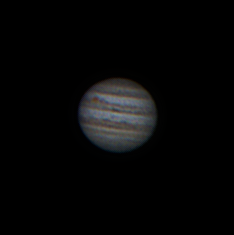| Date | Event |
|---|---|
| June 9 | First Quarter |
| June 10 | Jupiter at Opposition |
| June 15 | Ceres 0.9°S of Moon |
When an planet is said to be in opposition it means it is directly opposite the Sun from the point of view of the Earth. On June 10, Jupiter will be in opposition and will rise as the Sun sets. Earth will be at its closest point to the big planet this year. It will be at its brightest and largest. Many planetary imagers spend time around oppositions taking pictures.
Below is an image I captured of Jupiter during its 2017 opposition. The Great Red Spot is clearly visible. I hope to spend time improving my planetary imaging this year if I can find the time.
 |
| Jupiter |
To find Jupiter, check out the bright object in the southeast sky sometime after 10 or 10:30pm.
The Moon will reach its first quarter phase during the evening of Sunday, July 9 and will be well positioned for great observing. The Moon will then move into conjunction with the dwarf planet Ceres (magnitude 7.4). Ceres is conveniently located above the tip of the Scopion's tail. It will get as close as 1.25° above Beta Scorpii and fit in many telescopic fields of view. Watch this region of space over a few days and you will see Ceres move amongst the background stars.
There is one rocket launch scheduled for this week with a Falcon 9 taking three radar Earth observation satellites into space for the Canadian Space Agency.
| Date | Event |
|---|---|
| June 12 | Falcon 9 - Radarsat Constellation Mission |
If you are looking for a good object in the sky to tell your friends about, look for M4. This globular cluster is located just to the west of Antares. Antares is the bright red star in Scorpius in the southern sky. If you can find Jupiter look just to the southwest and you should see a bright red naked eye star. A lot of people confuse it with Mars due to the ruddy colour and relative brightness. In fact, the name Antares means the 'adversary of Ares' or the adversary of the god of war. Mars is the god of war in the Roman pantheon.
When you find Antares, immediately put it into a binocular field. You should see a cluster of stars (or blurry patch of light) just to the west. This is M4 which sits more than 7,000 light years away from Earth and measures nearly 75 light years across. A very large object and the first globular cluster in which individual stars were resolved.
Spend some time outside under clear skies this week and point out some Spring constellations to your friends, including Leo, Virgo, and Boötes! Click on the links to aid your search!
Subscribe to our Facebook page for the latest news and updates on the sky!
www.facebook.com/simonjastronomy


0 comments:
Post a Comment